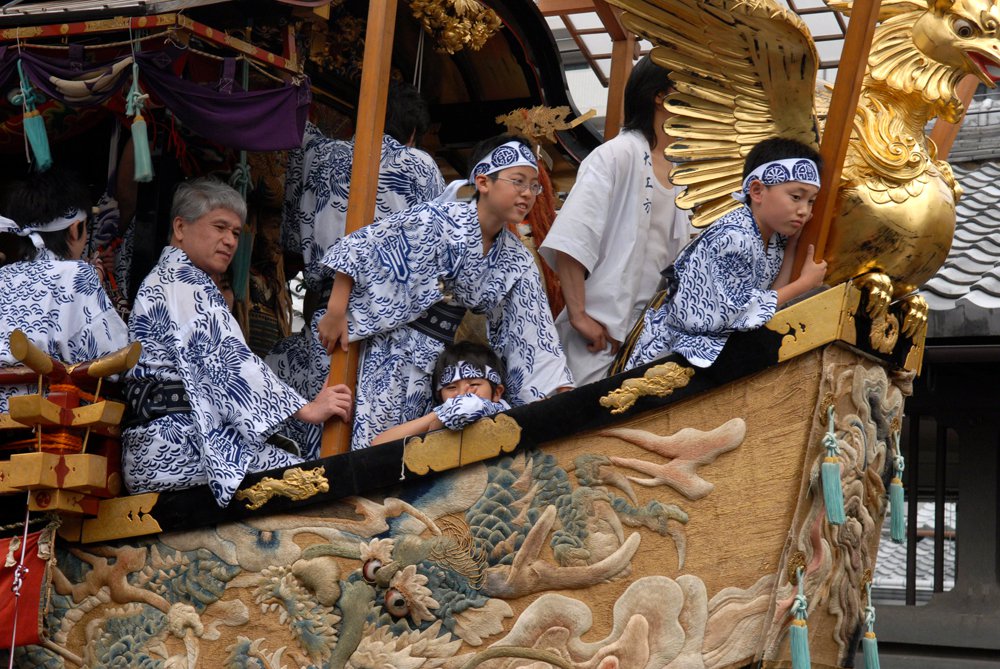(written for Zenbird in August 2021)
For more than one thousand years, Kyoto has held Japan’s biggest festival, the Gion Festival. In a regular year, throughout the month of July, more than one million people crowd into downtown Kyoto City to experience the street stalls, the towering wooden floats adorned with gorgeous antiquities from the Silk Road, their parade and the constant jangle of ancient music. All this happens amid the oppressive heat and damp of the rainy season.
It began in 869 on the directive of the emperor, with the aim of appeasing the gods at a time when epidemics had ravaged the city three times that decade. Despite centuries of change, the festival continues. We talk with author Catherine Pawasarat about why the festival has lasted so long and what it can teach us about living sustainably.
Pawasarat has studied the festival for decades, since living in the community during the 1990s. Her book, “The Gion Festival: Exploring Its Mysteries,” is the first comprehensive English-language guide to the festival. Much of its content is new even to the Japanese public and is born of the close relationships that she has maintained with festival organizers.
Community pride and commitment
One of the keys to the festival’s sustainability, Pawasarat says, is its connection to community. “The neighborhoods are really proud of their floats and their history and they really want it to continue and they are really willing to commit themselves to helping it continue.”
There are currently 34 floats, which are assembled, maintained and displayed by residents of each of the various neighborhoods. In its heyday, the kimono industry was the backbone of this area, and of the festival. It was the kimono merchants’ display of wealth and stature that adorned the floats with artworks that include textiles from as far away as Europe. They would close their businesses for the month of July so that their employees could devote themselves to working on the festival, instead, Pawasarat says. The decline of the kimono industry has robbed the festival of that reliable patronage and workforce.
Urban flight is also taking a toll. Costly inheritance taxes make it hard to keep local buildings in the family. And as downtown real estate prices skyrocket, it’s more profitable to build a parking lot or an apartment building than to maintain one of the traditional buildings that the communities usually use to house their floats.
“The apartments are being bought by Tokyo people who want to come and spend the weekend in Kyoto, but they don’t necessarily have a link to the Gion Festival. So that’s a big challenge right now that the festival has never experienced before.”
Adaptability and autonomy are crucial to survival
Many of the neighborhoods are staying afloat by adapting to these changes. Pawasarat gives the example of how the Koi-yama float made the opening of a big apartment building work with its needs. “They did it very skillfully. Every person who moved in was given a packet of information about the Koi-yama float and the Gion Festival and they were invited to participate. And they managed to do it in such a way that it’s mutually supportive with the traditional residents and is working quite well.”
Modern technology is also being used. Two floats that have been reconstructed in order to rejoin the festival (Taka-yama and Ofune-boko) have used crowdfunding to do that, Pawasarat says. It enabled them to receive donations from all over Japan. The festival’s “chimaki” talismans are also being sold online now, particularly while the parades and street stalls have been canceled due to the COVID-19 pandemic. Some communities have created online, 3D videos that explain their floats.
Another key to the sustainability of the overall festival is the number of floats. It means, for example, that the loss of the two floats mentioned above, due to a large fire in 1864, didn’t threaten the existence of the event. In modern times, too, as many of the floats struggle with common challenges, they can learn from each other. Within that camaraderie, the independence that each float has is also crucial to the festival’s continuity.
“There are now 34 floats, and they do all have a fair bit of autonomy in terms of self-direction, deciding how they want to do their float, how they want to organize, and so on. I think that really makes for great sustainability,” Pawasarat says.
That autonomy allows adaptability. It has meant that while some of the floats stick stoically to the principle of not permitting women to take a hands-on role, some are now including them, particularly as musicians.
“In some cases it comes down to these little girls that are just like, ‘Dad, I really want to play music.’ And the Dad is like, ‘OK, honey, I’ll ask.’ And if people say ‘yes,’ then it all changes. It’s kind of amazing,” Pawasarat says. “That freedom within the structure helps a lot in terms of sustainability.” Click here to continue reading.
*************
For more about the Gion Festival, be sure to visit Catherine Pawasarat’s website.
Click here to read more about Kirsty Kawano and her writing.

